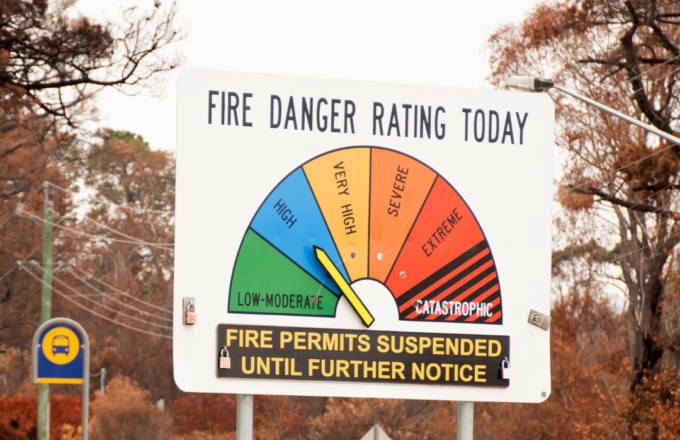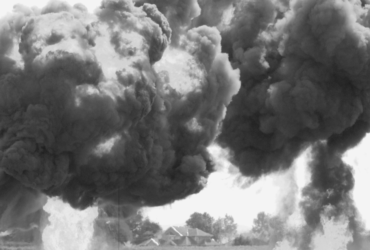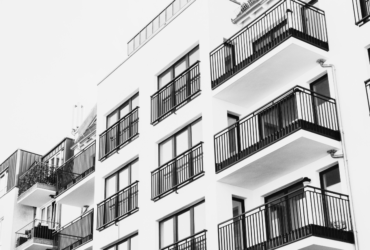
How are bushfire ratings classified?
October 31, 2023
Fire Danger Ratings let you know how dangerous a fire would be if one broke out in your area today.
Ratings are calculated using a combination of weather forecasting and information about vegetation that could fuel a fire. The ratings are based on a combination of different weather conditions known to influence the risk of dangerous bushfire conditions in Australia, including temperature, rainfall, humidity, and wind speed.
The Australian Fire Danger Rating System (AFDRS) is nationally consistent, so wherever you go in Australia, you can understand the level of threat and what you need to do to stay safe.
Behind the ratings
Fire danger ratings describe the potential level of danger should a bushfire start. They give you valuable information so you can take action to protect yourself and others. The AFDRS has four levels, each with a distinct title, colour, and key message.

MODERATE: Plan and Prepare – Most fires can be controlled – Stay up to date and be ready to act if there is a fire.
HIGH: Be Ready to Act – Fires can be dangerous
- Decide what you will do if a fire starts.
- There’s a heightened risk. Be alert for fires in your area.
- If a fire starts, your life and property may be at risk. The safest option is to avoid bushfire risk areas.
EXTREME: Take Action Now to protect your life and property. Fires will spread quickly and be extremely dangerous
- These are dangerous fire conditions.
- Check your bushfire plan and make sure your property is fire-ready.
- If a fire starts, take immediate action.
- If you and your property are not prepared to the highest level, go to a safer location well before the fire impacts.
- Reconsider travel through bushfire risk areas.
CATASTROPIC: For your survival, leave bushfire risk areas – If a fire starts to take hold, lives are likely to be lost
- These are the most dangerous conditions for a fire.
- Your life may depend on the decisions you make, even before there is a fire.
- For your survival, do not be in bushfire-risk areas.
- Stay safe by going to a safer location early in the morning or the night before.
- If a fire starts and takes hold, lives, and properties are likely to be lost.
- Homes cannot withstand fires in these conditions. You may not be able to leave, and help may not be available.
By understanding the risk and what that means to your life, your loved and your property, you can avoid risky situations that could cost lives. Remember things can always be replaced but your family and friends are irreplaceable… Now that we have explained the rating, we also wanted to touch on changes following the ‘Black Saturday’ and ‘Blue Mountains’ bushfires in recent years. The Australian Government in conjunction with local councils and fire services, has amended the requirements set out in Australian Standard 3959 -Construction of Buildings in Bushfire Prone Areas.
A Bushfire Attack Level (commonly known as BAL) Rating has now been applied to all domestic buildings located within 100 metres of bushland vegetation.
The BAL Ratings that have been assigned (from lowest to highest) are:

These ratings are based on factors such as the region where you live, the vegetation type around your property, the distance from your home to individual vegetation types, and the slope of the property.
This means that if your property now has a BAL Rating applied to it, then the costs to repair or rebuild your property have increased, sometimes dramatically, to comply with the new amended Australia Standard laws. The additional costs are not strictly limited to fire damage only but also apply to all claims affecting the external components of the building such as roof, walls, gutters, eaves, windows, doors, decks etc. So if your property suffers damage through events such storms, hail, impact, accidental damage etc. then the repair costs will be impacted by the BAL Rating.
So what does this mean for insurance? Depending on the BAL Rating applicable to your property, the additional costs associated with the rectification of damage caused to your property, be it by fire, storm, impact, etc. need to be included within your Building Sum Insured and not be exhausted under your insurance policy.
The Building Sum Insured nominated on your insurance policy now needs to be increased to include these additional costs otherwise it will result in under-insurance leaving you with either an unfinished home or personal financial contribution (outside insurance) to complete the repair or rebuild of your property.
The recommended additional costs have been set at:
1. BAL – LOW
No additional cost
2. BAL – 12.5
Additional $5,000 – $15,000
3. BAL – 19
Additional $20,000 – $30,000
4. BAL – 29
Additional $30,000 – $50,000
5. BAL – 40
Additional $50,000 – $80,000
6. BAL – FZ (Flame Zone)
Additional $100,000 – $120,000
In order to determine the BAL Rating applicable to your property, please contact your local council who will be able to provide you with this information. Once obtained, a calculation can be provided for the average additional costs that should be included in your building sum insured and added to your insurance policy to ensure you are adequately protected in the event of a loss. Did you want to add something about how it impacts insurance?
Download our free Bushfire Preparation Guide HERE



